NAPFA
NAPFA
- Maximum number of bent-knee Sit-Ups (with hands cupping ears) in one minute as a measure of anterior abdominal muscular endurance and strength.
- Better of two consecutive Standing Broad Jump distances, as a measure of lower limb extensor muscular power.
- Better of two consecutive Sit-and-Reach distances, as a measure of forward trunk flexibility, hip flexion and hamstring muscle stretch.
- Maximum number of Inclined Pull-Ups in half a minute, as a measure of upper limb muscular endurance and strength.
- Faster of two attempts to complete 4 x 10 m Shuttle Run, as a measure of general speed, agility and coordination.
- Minimum time taken to run/walk 1.6 km on a firm and level surface, as a measure of cardiorespiratory endurance (or aerobic) fitness and lower limb muscular endurance.
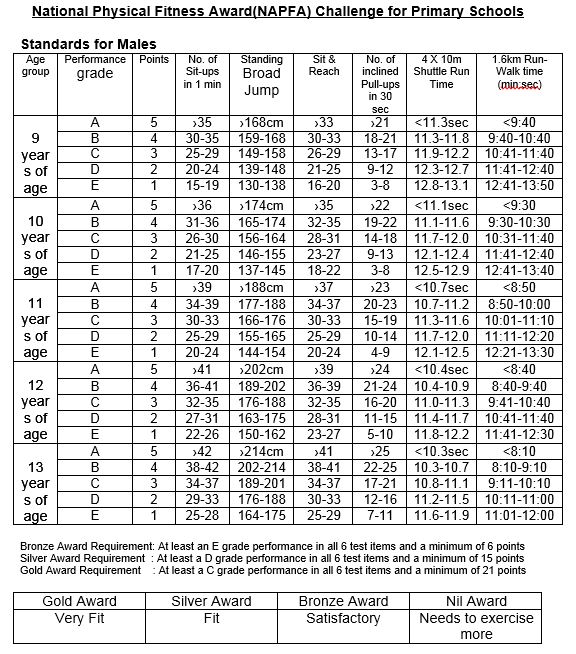
Safety Guidelines for NAPFA Test
- Ensure that all the NAPFA testers have attended the NAPFA Testers’ course. Other teachers assisting in the NAPFA test must be thoroughly briefed by a qualified tester in the school.
- Advise pupils not to take the test if they are unwell or are suffering from acute infection (e.g. viral influenza, chest infection) or injury.
- Advise pupils not to continue exercising should significant medical problems (including infections and injuries) develop, as it may result in serious complications and even death. They should resume training only after they have fully recovered and should progress gradually.
- Ensure that pupils warm-up and cool down before and after the test.
- Advise pupils not to consume heavy meals 1-2 hours before the test.
- Ensure that pupils wear sports or PE attire, i.e. short-sleeved T-shirt, shorts and sports or PE shoes. Shoes with worn out soles are not safe and should not be used during the test.
- Advise pupils who are less fit to start with low intensity training from the beginning of the school year and progress gradually.
- Note that the 1.6 km/2.4 km. run/walk test should preferably be conducted before 10 am and after 4 pm when the weather is relatively cooler.
- Ensure that water and First Aid stations are available during the test.
- The following categories of pupils are completely exempted from the NAPFA Test: 1. Pupils with medical problems (e.g. heart problems, soft bones etc.) and/or those advised not to participate by the SHS after their annual check-up. 2. Pupils with medical certificates for serious/long-term illnesses, e.g. cancer, hole in the heart, etc. 3. Pupils with physical disabilities. 4. Pupils recovering from fractured arm/foot/leg or serious illnesses such as chicken pox or dengue fever. 5. New cases of severely overweight pupils who have yet to obtain a certification of fitness from the School Health Service.
- Ensure that the following categories of pupils with minor illnesses are excused on the NAPFA test days: 1. Pupils with medical certificates. 2. Pupils with parents’ letter stating that they are not well. 3. Pupils whom teachers have observed to be unwell. 4. Pupils who report sick
- Accept all MCs and parents’ letters at face value. Pupils having minor illnesses such as mild flu, cold and cough (without chest infections), slight fever, menstrual cramps and diarrhea should take the test two weeks later when they have fully recovered.
Test Item No. 1
Bent-Knee Sit-Ups (With hands cupping ears)
Equipment/Facilities
- Clean floor, mat or other firm, comfortable surface
- Stopwatch
- Whistle or other equipment to indicate start, 15-second intervals and end of minute, particularly if several pupils are tested together.
Description
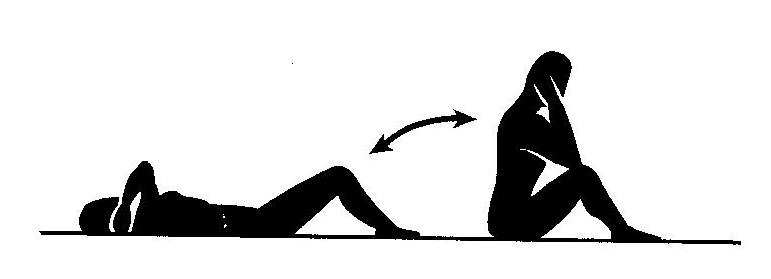
- Lie flat on back, knees bent about 90, feet shoulder-width apart and keep flat on surface by partner holding ankles. This is the starting position.
- With hands cupping the ear, curl up to touch right knee with right elbow and left knee with left elbow simultaneously, before returning to starting position.
- One sit-up is counted each time the elbows touch the knees. Resting between sit-ups is permitted.
Suggestions to improve on Sit-ups
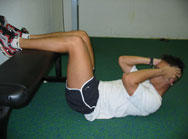
- Do crunches (lie on your back with head off the floor, position legs on bench at 90-degree angle to the floor).
- Interval training –
- 15 seconds do as many crunches/sit-ups as possible
- turnover and rest on tummy for 15 seconds
- then repeat process
- Abdominal stretches
- Leg lifts while lying on the floor
- Seated Knee-ups
- Sit on a large stadium step or bench, grip the edges
- Lean back and extend your legs till parallel to the floor
- Bring your knees to your chest without moving your upper body
- Trunk Curl
- Raise head and shoulders
- Hold for 5 seconds
- Repeat
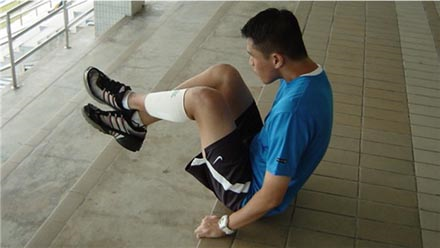
- Sit-ups with Straight Arms
- Crossed Arms Sit-ups
- Cycling while lying on the ground
- All the above modified sit-ups but with partner holding onto one’s legs
Specific rules and procedures
- One teacher tester to a maximum of six pupils at a time.
- Pupil assistant to count aloud. Bouncing of the body off the mat is not permitted. Shoulder blades are expected to contact the mat- head does not need to contact the mat.
Test Item No. 2
Standing Broad Jump
Equipment/Facilities
- Standing Broad Jump mat with markings or firm, level, non-slip surface
Description
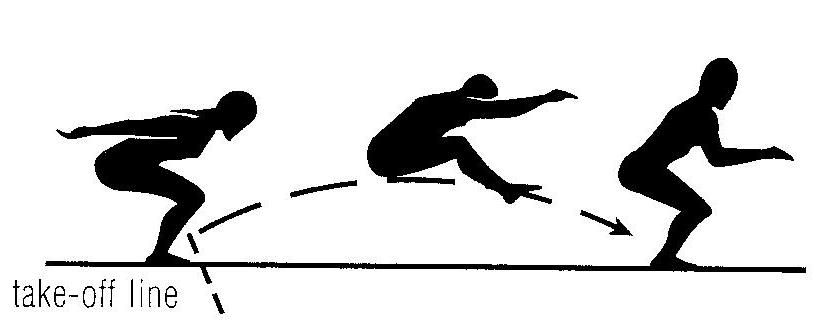
1. Stand with feet about shoulder-width apart, toes just behind take-off line.
2. Prepare to jump forward by swinging arms back and bending knees about 90
3. Jump as far forward as possible, taking off with both feet. Attempt not counted if subject loses balance and falls backwards touching area behind feet.
4. Distance noted, to nearest cm, between take-off line and heel nearer to line. Better of two attempts shall count.
Suggestion to improve on Standing Broad Jump:
- Work on jumping technique
- Tug-jumps
- Star-jumps
- Bunny hops
- One-leg hops
- Kangaroo jump
- Jump over obstacles (ball/hurdles) placed a distance apart
- Jump for height
Specific rules and procedures
- One teacher tester to observe and test one pupil at a time.
- Sliding forward can be considered a legitimate jump and be measured
provided the tester/teacher is able to determine the original landing
point. If the tester cannot read off the mark, then it can be considered as
a no attempt.
Test Item No. 3
Sit-and-Reach
Equipment/Facilities
- Sit-and-Reach equipment
Description
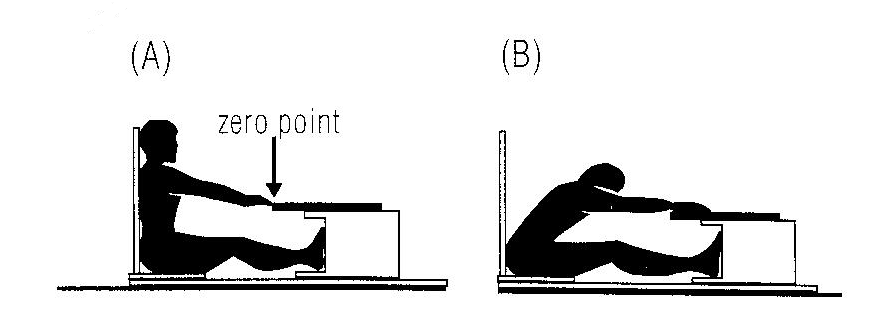
- Sit upright with the head, back, shoulders and hips against the back-rest (or wall) and place both feet, shoulder width apart, against the foot-rest.
- Stretch out both arms in front of the body with hands together, palm down, thumbs interlocked and fingers in contact with each other, middle finger touching tip of sliding rule (zero point) and maintaining body position throughout as in 1. This is the starting position.
- In one movement, reach forward as far as possible, sliding fingertips along the top of the sliding rule, and hold the extreme position for at least 2 seconds.
- The furthest distance reached by the fingertips, to the nearest centimeter, is the performance score.
- The better of two attempts shall count.
Suggestions to improve on Sit-and-Reach
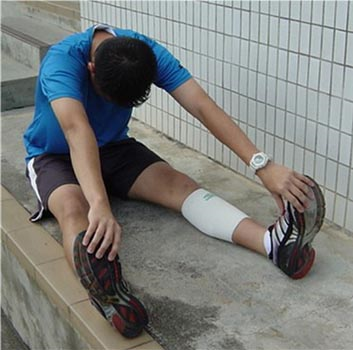
- Double Hamstring Stretch
- Sit with your legs extended, hold on to the
toecap of your shoe and relax. - Hold for 10 counts, stop and repeat.
- Sit with your legs extended, hold on to the
- Work on flexibility through gymnastics/stretching exercises
- Rowing motion with legs straight
- Elevated stretch
- Reach out to toes
- Hold for 5 counts
- Repeat with other leg
Specific rules and procedures
- One teacher tester to observe and test one pupil at a time.
- Pupils should remove their shoes to reduce any disadvantage.
Test Item No. 4
Inclined Pull-Up
Equipment/Facilities
- Stopwatch
- Inclined pull-up bars
Description

- Lie supine (face up) under the horizontal bar with the chin bar directly over the eyes. (The outstretched hands should be about 5cm beyond reach of the horizontal bar).
- Reach up to hang from the bar with an overhand grasp (palm forward), hands shoulder width apart and elbow straight (body should not bend at the hips) with heels resting on the floor. This is the starting position.
- Pull up until the chin reaches the elastic band (not necessarily touching it), keeping the body straight at all times. This is one pull-up. Return to starting position. The pull up will not count if the chin fails to reach the elastic band or when any part of the body (other than heels) touches the floor.
- Repeat, doing as many pull-ups as possible in 30 seconds or until no more complete pull-ups are possible, whichever comes first. The number of completed pull-ups is the performance score.
- Rest between pull-ups is permitted.
Suggestions to improve on Inclined Pull-Up
- Push-ups
- Arm-wrestling
- Working on arm strength through ball games
- Inclined hang
- Use overhand grip
- Hang as long as you can on the bar in a rest position
- Inclined pull-up hand
- Use overhand grip
- Hang as long as you can on the bar in a pull-up position
Specific rules and procedures
- One teacher tester to observe and test one pupil at a time.
Test Item No. 5
4 x 10M Shuttle Run
Equipment/Facilities
- Stopwatch
- Inclined pull-up bars
- Two bean bags
- Firm, level, non-slip surface
Description
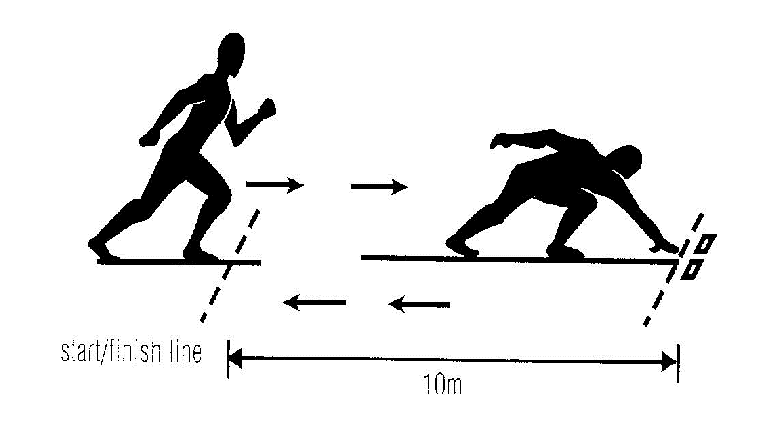
- Two small objects (eg. bean bags) placed about 1 m apart behind one line.
- Stand behind other line which should be 10 m. away from first line.
- At start of timing, run, pick up first object, run back and place object behind second line; return to first line, pick up second object and run towards and across second line. No need to place down second object.
- Time noted, to nearest tenth of second, to complete shuttle-run.
- The better of two attempts shall count.
Suggestion to improve on Shuttle Run
- 5m/ 10 m sprints
- Agility runs
- Work on picking up and placing down bean-bag technique
- Side to side reach
- Turn and reach for line as quickly as you can
- Zig-zag run
Specific rules and procedures
- One teacher tester to observe and test one pupil at a time.
- Pupils are not allowed to throw/drop the first object behind the
start/finish line. - Tester is to position himself/herself at the start/finish line.
- Tester stops the timing when the torso of the pupil crosses the line.
- Rest is allowed between the runs.
Test Item No. 6
1.6 km Run/Walk
Equipment/Facilities
- Stopwatch/Multi-timer
- Position Cards
- Firm, level, non-slip surface
Description
- Run, jog or walk on firm and level distance in the shortest time possible.
- Resting during test permitted.

